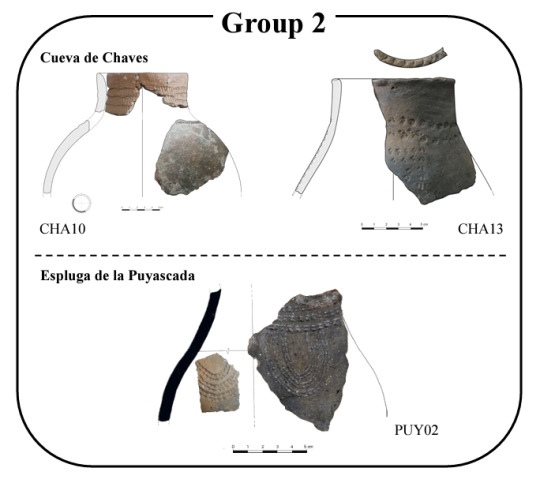#OrganicResidues
Explore tagged Tumblr posts
Text
What’s Left on the Neolithic...plate?
ITA version ESP version
Sometimes, not having soap to wash the dishes thoroughly can be useful... especially if we want to uncover our past activities. It is thanks to the residues found in ancient ceramic vessels that a research team, composed of members from the Universitat Autònoma de Barcelona (UAB), the University of Zaragoza, and the University of Strasbourg, has revealed the first direct evidence of the consumption and processing of dairy products since the beginning of the Neolithic period, around 7,500 years ago.
The study utilised the remains of about thirty ceramic vessels obtained from two archaeological sites found in the caves of Chaves and Puyascada, located in the province of Huesca, Spain, to understand the usage and preservation habits of food. The researchers organised and classified the vessels according to various criteria, such as the type of profile, shape, cooking conditions, surface treatment, type of decoration, depth, and volume. Subsequently, lipids were extracted from the ceramic remains using a technique that employs acidified methanol, then analysed through gas chromatography and mass spectrometry.
Thanks to the morphological profiles, the researchers classified the vessels based on their function: preparation with or without heating, serving, and storage. Indeed, a group of ceramic pots was classified as suitable for food preparation, particularly for prolonged boiling thanks to the closed rims that prevent excessive evaporation. Others were suitable for pounding or stirring, as they have thick walls, which would be more resistant to heavy impacts. Regarding organic matter, the residues found in the vessels include ruminant fats, pork, plant products, and dairy, suggesting intentional mixing or subsequent uses.
Another group of small vessels was interpreted as serving containers, used for individual consumption of food and liquids. They could have been easily handled with one hand, so they were likely intended for individual use. The identified ingredients range from animal fats to edible plants and resins. Finally, a last group of vessels, with deep and closed necks, was considered ideal for storing liquids and low-fat foods, such as cereals and legumes.
The analysis of organic residues from the Chaves ceramics indicates that these were mainly used for processing ruminant meat, representing 50% of the residues, and dairy products, which constitute 28%. This is consistent with the mortality profiles of the animals at Chaves, which show that goats, cattle, and pigs were slaughtered young, during the so-called "optimum of meat". At Puyascada, on the other hand, the ceramics were mainly used for dairy products, which account for 54% of the organic residues, while ruminant fats only make up 27%, and pork fat is well represented at 36%. The low percentage of ruminant fats could be due to different preparation and consumption methods compared to Chaves.
The high percentage of dairy fats at Puyascada suggests a priority in the use of ceramics for milk processing. Additionally, the importance of pork fat, despite the low quantitative presence of the species, could indicate specific preparation of pork or its use as a fat reserve. The preparation and consumption of pork fat were widespread practices in Neolithic Iberia, with evidence in many archaeological sites. The data suggest that, while milk was processed and consumed at both sites, ruminant and pork fats were managed differently, reflecting distinct production and consumption strategies.
From the shape of the vessels and the organic residues, scientists have managed to offer a valuable window into the social dynamics and agricultural and livestock practices of Neolithic communities in the Iberian Peninsula.
Other previous studies confirm the production of dairy products in Europe during the Neolithic, but this is the first study that makes a direct comparison between neighbours, between caves located about 100 km apart, describing the diversity of lifestyles.
source: https://link.springer.com/article/10.1007/s12520-024-02001-9#Sec14
examples of ceramic vessels:

#Archaeology#Neolithic#AncientHistory#PrehistoricCulture#ScientificResearch#Discoveries#AncientPottery#OrganicResidues#PrehistoricFood#Spain#AutonomousUniversityOfBarcelona#UniversityOfZaragoza#UniversityOfStrasbourg
5 notes
·
View notes